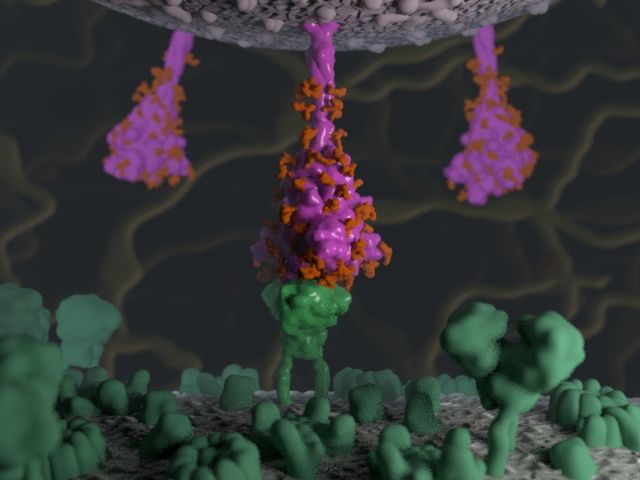New Web App to help demystify why Covid mutations have the effects they do
Published: 9 September 2021
Why is the Delta variant so virulent ? Why did it surpass the Beta variant so quickly? An innovation by a GSA-University of Glasgow Masters graduate’s is set to help understand why certain variants dominate and have the impact they do.
The SARS-CoV-2 pandemic has focussed everyone’s attention on the hidden world of viruses. The emergence of new variants such as Beta and Delta, affects us all: some variants spread more quickly and some are less affected by vaccines. But why?
Teams of scientists around the world, including the COVID-19 Genomics UK (COG-UK) consortium, are tracking the emergence of new variants of SARS-CoV-2, but to understand why the mutations they report have the effects they do requires an expert understanding of the details of how SARS-CoV-2 functions, something which the majority of us do not have. For most of us, the reason these mutations will affect us is hard to visualise.

In response to this Sarah Iannucci, an MSc in Medical Visualisation and Human Anatomy at The Glasgow School of Art (School of Simulation and Visualisation) and University of Glasgow (School of Life Sciences), set out to explain the hidden workings of SARS-CoV-2 and its variants, particularly those on the viral spike protein.
Sarah built the SARS-CoV-2 Spike Mutation Explorer, an interactive web application using illustration, animation and interactive 3D models to explain why SARS-CoV-2 mutations have the effects they do, with users able to view and interact with visualisations of variants of concern and their characteristic mutations. The work was unveiled today, 9 September 2021, as part of The Glasgow School of Art’s Postgraduate Showcase.
The SARS-CoV-2 Spike Mutation Explorer was developed in collaboration with COG-UK, and with it Sarah aims to provide the context needed for non-experts such as the media to understand the technical reports on SARS-CoV-2 variants presented in the COG-UK website and then share them with the wider public.
“For me biomedical illustration is about visually impactful and educational storytelling, aiming to take complex scientific topics and implement engaging, clear visualisations in order to facilitate the audience’s understanding,” says Sarah.
“The SARS-CoV-2 spike protein, which is responsible for viral infectivity and transmissibility, is mutating rapidly and with it, Variants of Concern (VOCs) are emerging. There is a pressing public need to understand these topics, as they have direct relevance to control measures, restrictions to daily life, and to illness.”
“I’m delighted that the SARS-CoV-2 Spike Mutation Explorer will be made available through the website of the MRC-University of Glasgow Centre for Virus Research and I hope that as well as enabling experts to explain more about the many variants of the virus, it will also make it easier for the broader public to learn more about why specific mutations become Variants of Concern and understand why particular measures are needed to combat them.”
Dr Ed Hutchinson, a senior lecturer at the MRC-University of Glasgow Centre for Virus Research, supervised the virology aspects of Sarah’s project.
“I first came across Sarah’s work when I saw ‘Deactivation,’ a detailed painting she had created showing how detergents destroy SARS-CoV-2, which she kindly let me use when teaching this topic to final year students at the University of Glasgow,” he explains.
“Shortly afterwards she began her MSc, I delighted to have the chance to work with her as she developed her ‘SARS-CoV-2 Spike Mutation Explorer’ app. Sarah has a real skill for using visual art to explain the complex world of molecular biology. She has used this to help people understand cutting-edge research that is being done on the most urgent scientific questions of our time – how SARS-CoV-2 is changing, and what this means for all of us.”
Dr Daniel Livingstone, Reader in Games and Learning Technology at The Glasgow School of Art, leads Postgraduate Programmes at the School of Simulation and Visualisation.
“I am thrilled that yet another of our Medical Visualisation & Human Anatomy students has produced work that is going to have real public impact, a testament to the continuing strength of our continued collaboration with the University of Glasgow
“Sarah’s work is a fantastic example of how technical, scientific and creative skills work together in the Medical Visualisation discipline to produce work that is not just visually engaging but also informative.
It is great that her work is going be form a key part of the efforts to explain the continuing SARS-CoV-2 story to the public.”
Enquiries: ali.howard@glasgow.ac.uk or elizabeth.mcmeekin@glasgow.ac.uk / 0141 330 6557 or 0141 330 4831
First published: 9 September 2021
<< September
Related Links
- Dr Ed Hutchinson, profile
- SARS-CoV-2 spike mutation explorer
- MRC-University of Glasgow Centre for Virus Research
- School of Life Sciences
- Institute of Infection, Immunity and Inflammation
- College of Medical, Veterinary and Life Sciences
- MSc in Medical Visualisation and Human Anatomy
- COVID-19 Genomics UK (COG-UK)
- Sarah Iannucci

